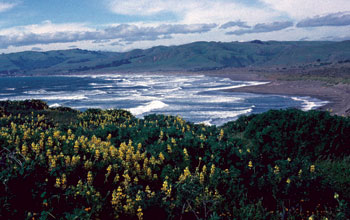Multimedia Gallery
Research at Bodega Marine Reserve
Research at Bodega Marine Reserve
Looking north along the Sonoma County, Calif., coast from Mussel Point, on the Bodega Marine Reserve (University of California Natural Reserve System). In the foreground are yellow bush lupines (Lupinus arboreus). In the background, waves are breaking onto Salmon Creek Beach, Sonoma Beach State Park.
Lupines in this population (Mussel Point) exhibit high but stable population densities. Adjacent lupine populations in the dunes (visible in the right margin of the photo) are sparser but also exhibit stable numbers. In contrast, lupines in grasslands closer to Bodega Head (about 1 km distant) can achieve very high densities but also exhibit mass die-offs, resulting in wildly fluctuating population densities.
Yellow bush lupine introduced into dune systems north of Bodega Marine Reserve are invasive and destroy native plant communities. Our research will help determine which methods will be most effective for controlling this plant in non-native locations.
Lupinus arboreus at Bodega Marine Reserve has been the focus of research supported by two grants from the National Science Foundation, awarded to Ellen Simms, integrative biology faculty member and botanical garden director at the University of California. The grants were awarded to study the effects of rodent granivory and insect herbivory on bush lupine population dynamics (co-supported with John L. Maron and Pam Kittelson under DEB 99-96236), and the ability of yellow bush lupine to allocate resources preferentially to more-beneficial bradyrhizobium. (Date of Image: June 1998)
Credit: Photo by Ellen L. Simms
Special Restrictions: Use of this image is limited to government and nonprofit use only. Any other use of this image is strictly prohibited.
Images and other media in the National Science Foundation Multimedia Gallery are available for use in print and electronic material by NSF employees, members of the media, university staff, teachers and the general public. All media in the gallery are intended for personal, educational and nonprofit/non-commercial use only.
Images credited to the National Science Foundation, a federal agency, are in the public domain. The images were created by employees of the United States Government as part of their official duties or prepared by contractors as "works for hire" for NSF. You may freely use NSF-credited images and, at your discretion, credit NSF with a "Courtesy: National Science Foundation" notation.
Additional information about general usage can be found in Conditions.
Also Available:
Download the high-resolution JPG version of the image. (3.3 MB)
Use your mouse to right-click (Mac users may need to Ctrl-click) the link above and choose the option that will save the file or target to your computer.



